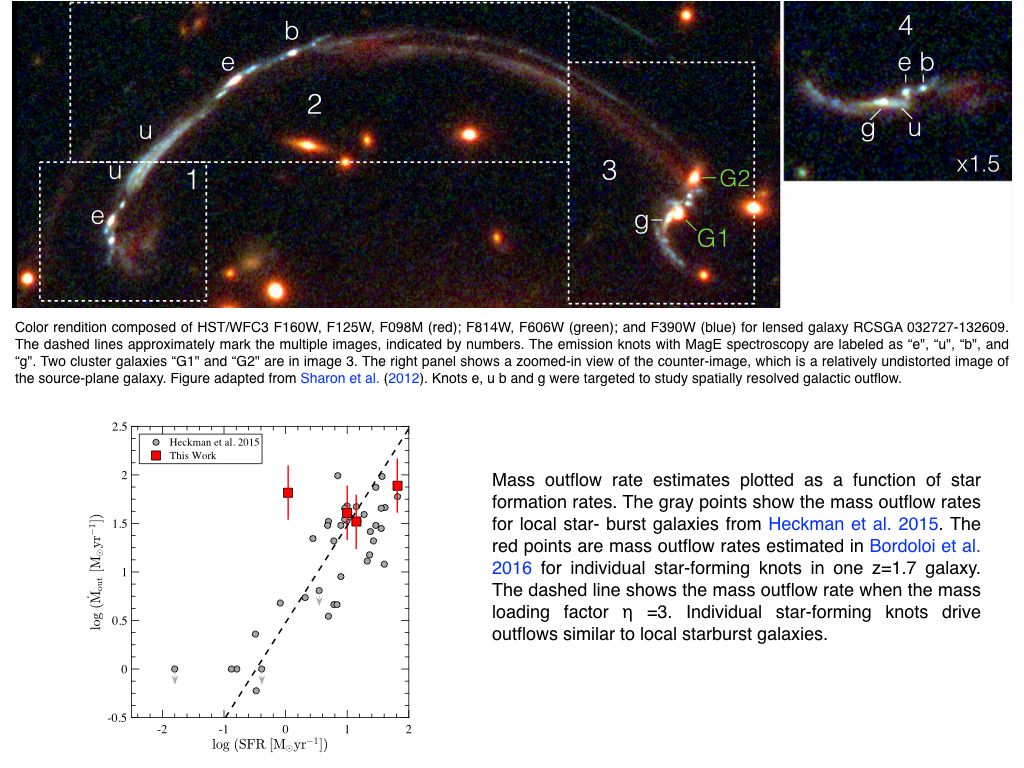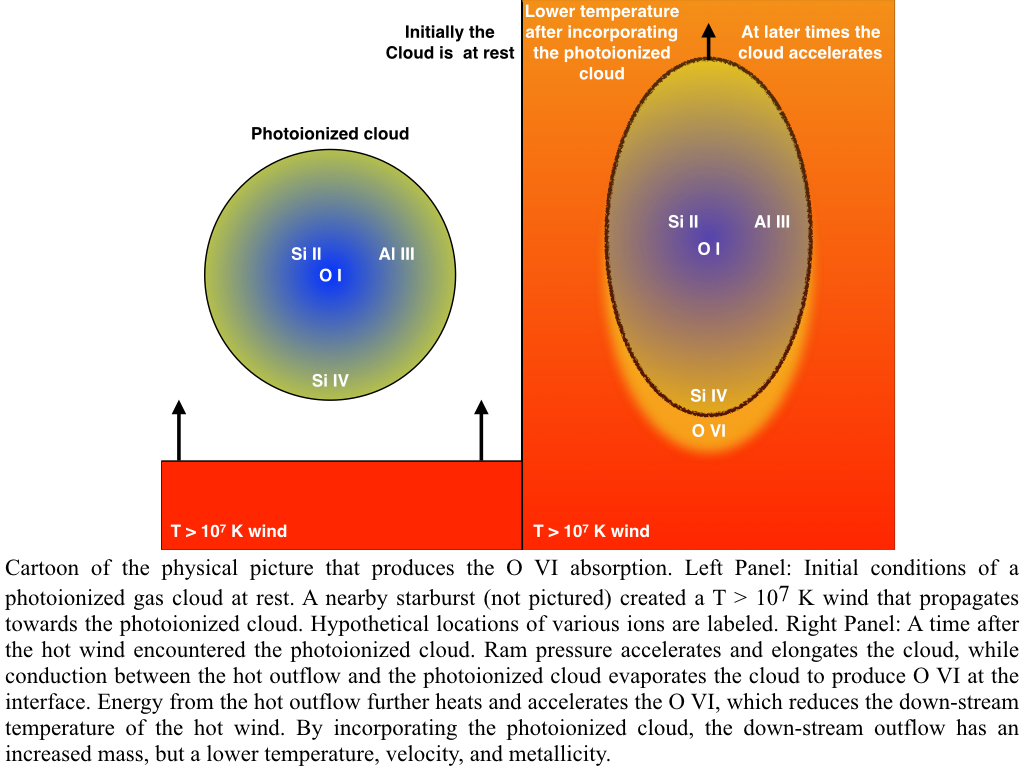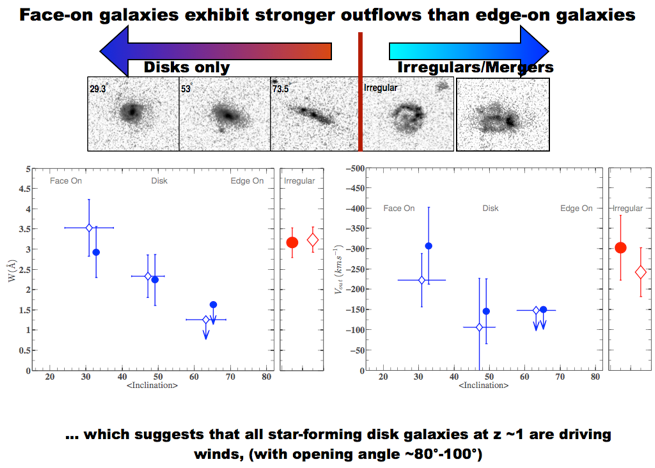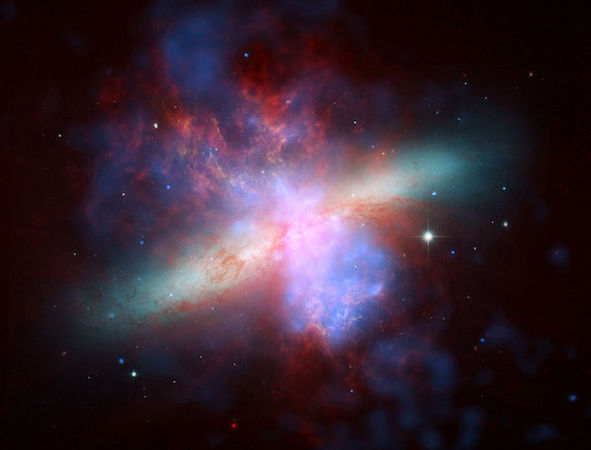Galactic Outflows
Galactic outflows are crucial in chemically enriching the circumgalactic medium as well as in regulating star-formation in a galaxy.
The modern theory of galaxy evolution demands strong feedback processes that regulate the exchange of gas into and out of galaxies.
Such processes are crucial in setting up the mass metallicity relation, the quenching of star-formation, and in explaining the mismatch between the galaxy stellar mass function and the dark matter halo mass function.
Some of my recent work on this field are listed below.
Spatially resolved galactic wind in lensed galaxy RCSGA 032727-132609 :
 We probe the spatial distribution of outflowing gas along four lines of sight separated by up to 6 kpc in a gravitationally lensed star-forming galaxy at z = 1.70.
Using MgII and FeII emission and absorption as tracers, we find that the clumps of star formation are driving galactic outflows with velocities of -170 to -250 km/s.
The velocities of MgII emission are redshifted with respect to the systemic velocities of the galaxy, consistent with being back-scattered.
By contrast, the FeII fluorescent emission lines are either slightly blueshifted or at the systemic velocity of the galaxy.
Taken together, the velocity structure of the MgII and FeII emission is consistent with arising through scattering in galactic winds.
Assuming a thin shell geometry for the outflowing gas, the estimated masses carried out by these outflows are large (≳30-50 M⊙/yr),
with mass loading factors several times the star formation rate. Almost 20 per cent to 50 per cent of the blueshifted absorption probably escapes
the gravitational potential of the galaxy. In this galaxy, the outflow is `locally sourced', that is,
the properties of the outflow in each line of sight are dominated by the properties of the nearest clump of star formation; the wind is not global to the galaxy.
The mass outflow rates and the momentum flux carried out by outflows in individual star-forming knots of this object are comparable to that of starburst galaxies in the local Universe.
For more details see Bordoloi et al 2016.
We probe the spatial distribution of outflowing gas along four lines of sight separated by up to 6 kpc in a gravitationally lensed star-forming galaxy at z = 1.70.
Using MgII and FeII emission and absorption as tracers, we find that the clumps of star formation are driving galactic outflows with velocities of -170 to -250 km/s.
The velocities of MgII emission are redshifted with respect to the systemic velocities of the galaxy, consistent with being back-scattered.
By contrast, the FeII fluorescent emission lines are either slightly blueshifted or at the systemic velocity of the galaxy.
Taken together, the velocity structure of the MgII and FeII emission is consistent with arising through scattering in galactic winds.
Assuming a thin shell geometry for the outflowing gas, the estimated masses carried out by these outflows are large (≳30-50 M⊙/yr),
with mass loading factors several times the star formation rate. Almost 20 per cent to 50 per cent of the blueshifted absorption probably escapes
the gravitational potential of the galaxy. In this galaxy, the outflow is `locally sourced', that is,
the properties of the outflow in each line of sight are dominated by the properties of the nearest clump of star formation; the wind is not global to the galaxy.
The mass outflow rates and the momentum flux carried out by outflows in individual star-forming knots of this object are comparable to that of starburst galaxies in the local Universe.
For more details see Bordoloi et al 2016.
Feeding the fire: Tracing the mass-loading of 10^7 K galactic outflows with O VI absorption :
 Galactic outflows regulate the amount of gas galaxies convert into stars. However, it is difficult to measure the mass outflows remove because they span a large range of temperatures and phases. Here, we study the rest-frame ultraviolet spectrum of a lensed galaxy at z~2.9 with prominent interstellar absorption lines from O I, tracing neutral gas, up to O VI, tracing transitional phase gas. The O VI profile mimics weak low-ionization profiles at low velocities, and strong saturated profiles at high velocities. These trends indicate that O VI gas is co-spatial with the low-ionization gas. Further, at velocities blueward of -200 km/s the column density of the low-ionization outflow rapidly drops while the O VI column density rises, suggesting that O VI is created as the low-ionization gas is destroyed. Photoionization models do not reproduce the observed O VI, but adequately match the low-ionization gas, indicating that the phases have different formation mechanisms. Photoionized outflows are more massive than O VI outflows for most of the observed velocities, although the O VI mass outflow rate exceeds the photoionized outflow at velocities above the galaxy's escape velocity. Therefore, most gas capable of escaping the galaxy is in a hot outflow phase. We suggest that the O VI absorption is a temporary by-product of conduction transferring mass from the photoionized phase to an unobserved hot wind, and discuss how this mass-loading impacts the observed circum-galactic medium.
For more details see
Chisholm J., Bordoloi, R., Rigby J. R., and Bayliss M. 2017, MNRAS in press.
Galactic outflows regulate the amount of gas galaxies convert into stars. However, it is difficult to measure the mass outflows remove because they span a large range of temperatures and phases. Here, we study the rest-frame ultraviolet spectrum of a lensed galaxy at z~2.9 with prominent interstellar absorption lines from O I, tracing neutral gas, up to O VI, tracing transitional phase gas. The O VI profile mimics weak low-ionization profiles at low velocities, and strong saturated profiles at high velocities. These trends indicate that O VI gas is co-spatial with the low-ionization gas. Further, at velocities blueward of -200 km/s the column density of the low-ionization outflow rapidly drops while the O VI column density rises, suggesting that O VI is created as the low-ionization gas is destroyed. Photoionization models do not reproduce the observed O VI, but adequately match the low-ionization gas, indicating that the phases have different formation mechanisms. Photoionized outflows are more massive than O VI outflows for most of the observed velocities, although the O VI mass outflow rate exceeds the photoionized outflow at velocities above the galaxy's escape velocity. Therefore, most gas capable of escaping the galaxy is in a hot outflow phase. We suggest that the O VI absorption is a temporary by-product of conduction transferring mass from the photoionized phase to an unobserved hot wind, and discuss how this mass-loading impacts the observed circum-galactic medium.
For more details see
Chisholm J., Bordoloi, R., Rigby J. R., and Bayliss M. 2017, MNRAS in press.
The Dependence of Galactic Outflows on the Properties and Orientation of zCOSMOS Galaxies at z ~ 1 :
 We present an analysis of cool outflowing gas around galaxies, traced by MgII absorption lines in the coadded spectra of a sample of 486 zCOSMOS galaxies at 1 <= z <= 1.5.
These galaxies span a range of stellar masses (9.45 <= log10[M */M⊙] <= 10.7) and star formation rates (0.14 <= log10[SFR/M⊙/yr] <= 2.35).
We identify the cool outflowing component in the Mg II absorption and find that the equivalent width of the outflowing component increases with stellar mass.
The outflow equivalent width also increases steadily with the increasing star formation rate of the galaxies. At similar stellar masses,
the blue galaxies exhibit a significantly higher outflow equivalent width as compared to red galaxies.
The outflow equivalent width shows strong correlation with the star formation surface density (ΣSFR) of the sample.
For the disk galaxies, the outflow equivalent width is higher for the face-on systems as compared to the edge-on ones,
indicating that for the disk galaxies, the outflowing gas is primarily bipolar in geometry.
Galaxies typically exhibit outflow velocities ranging from -150 km/s ~-200 km/s and, on average, the face-on galaxies exhibit higher outflow velocity as compared to
the edge-on ones. Galaxies with irregular morphologies exhibit outflow equivalent width as well as outflow velocities comparable to face on disk galaxies.
These galaxies exhibit mass outflow rates >5-7 M⊙/yr and a mass loading factor comparable to the star formation rates of the galaxies.
For more details see Bordoloi et al 2014.
We present an analysis of cool outflowing gas around galaxies, traced by MgII absorption lines in the coadded spectra of a sample of 486 zCOSMOS galaxies at 1 <= z <= 1.5.
These galaxies span a range of stellar masses (9.45 <= log10[M */M⊙] <= 10.7) and star formation rates (0.14 <= log10[SFR/M⊙/yr] <= 2.35).
We identify the cool outflowing component in the Mg II absorption and find that the equivalent width of the outflowing component increases with stellar mass.
The outflow equivalent width also increases steadily with the increasing star formation rate of the galaxies. At similar stellar masses,
the blue galaxies exhibit a significantly higher outflow equivalent width as compared to red galaxies.
The outflow equivalent width shows strong correlation with the star formation surface density (ΣSFR) of the sample.
For the disk galaxies, the outflow equivalent width is higher for the face-on systems as compared to the edge-on ones,
indicating that for the disk galaxies, the outflowing gas is primarily bipolar in geometry.
Galaxies typically exhibit outflow velocities ranging from -150 km/s ~-200 km/s and, on average, the face-on galaxies exhibit higher outflow velocity as compared to
the edge-on ones. Galaxies with irregular morphologies exhibit outflow equivalent width as well as outflow velocities comparable to face on disk galaxies.
These galaxies exhibit mass outflow rates >5-7 M⊙/yr and a mass loading factor comparable to the star formation rates of the galaxies.
For more details see Bordoloi et al 2014.
